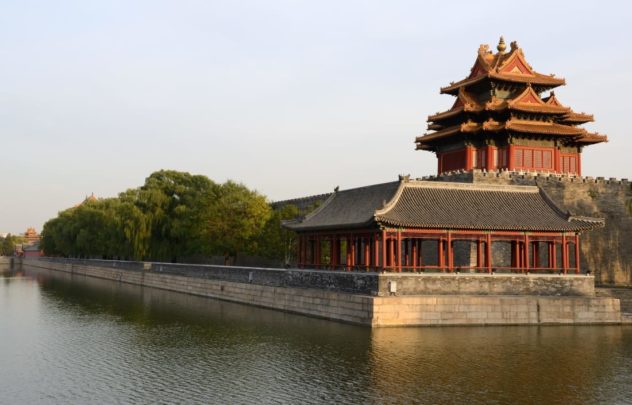© Frédéric Soltan/Corbis/Getty Images via CNN
Pre-reading questions:
I will read each question. Then, please answer them.
講師がそれぞれの質問を読むので答えましょう。
- Have you been to China?
- What places do you like visiting?
Vocabulary:
I will read the words, meanings, and sample sentences. Then, repeat after me.
単語、意味、例文を読みます。講師に続いて音読しましょう。
- factory /FAK-tuh-ree/
- cover /KUHV-er/
- moat /moht/
- atmosphere /AT-mhs-feer/
- natural /NACH-ruhl/
[noun] – a building or buildings where people use machines to produce goods
My older brother works at a shoe factory.
[verb] – to put or spread something over something; or to lie on the surface of something
If you have no umbrella, use your scarf to cover your head.
[noun] – a large hole filled with hole dug around a palace or castle to protect it from attacks
The palace has no moats, which is why it was attacked so easily.
[noun] – the character, feeling, or mood of a place or situation
I don’t like the atmosphere of this abandoned house, it’s really scary.
[adjective] – as found in nature and not involving anything made or done by people
The skin cream Sarah uses is made of natural ingredients.
Article reading:
Please read the whole article. Then, I will check your pronunciation and intonation.
記事を音読しましょう。講師はあなたの発音とイントネーションを確認します。
The Forbidden City in Beijing, China turned 600 this year. The temples and city walls were turned to factories and schools, but the imperial palace still stands proud and strong. What historical and cultural value does it have?
The imperial palace complex is the largest in the world, covering 720,000 square meters of land. Its 10-meter high wall and 52-meter wide moat give off a powerful atmosphere, offering protection to the emperor and showing his rule over his people. The designs inside the palace consist of golden yellow tiles that represent the emperor’s connection to the sun, and the dragon symbolizes the power given to him.
For 600 years, the Forbidden City has survived natural disasters like fires and earthquakes, and even political conflict. Now, China chose it as the symbol of the country’s rich culture and history. The government has decided to invest on its restoration to preserve its value in the years to come. Will you visit the Forbidden City someday?
The imperial palace complex is the largest in the world, covering 720,000 square meters of land. Its 10-meter high wall and 52-meter wide moat give off a powerful atmosphere, offering protection to the emperor and showing his rule over his people. The designs inside the palace consist of golden yellow tiles that represent the emperor’s connection to the sun, and the dragon symbolizes the power given to him.
For 600 years, the Forbidden City has survived natural disasters like fires and earthquakes, and even political conflict. Now, China chose it as the symbol of the country’s rich culture and history. The government has decided to invest on its restoration to preserve its value in the years to come. Will you visit the Forbidden City someday?
True or False:
Read the sentences and identify if they are true or false based on the article.
文章を読んで、記事に基づいて正誤を答えましょう。
- The imperial palace complex covers 720,000 square meters of land.
- China chose the Forbidden City to symbolize its rich culture and history.
- The dragon in the imperial palace symbolizes its connection to the emperor.
- The Forbidden City turned 60 this year.
- The temples and city walls around the Forbidden City turned to factories and schools.
Fill in the blanks:
Choose the correct word from the table then fill in the blanks.
適切な言葉を選んで空欄を埋めましょう。
| factory | cover | moat | atmosphere | natural |
- It’s important for castles to have _____ to protect it from invaders.
- _____ disasters like typhoons are difficult to avoid.
- The new building _____ most of the land left in the village.
- She wanted to work in a clothing _____ when she was a child.
- This hotel gives me an unseasy _____.
